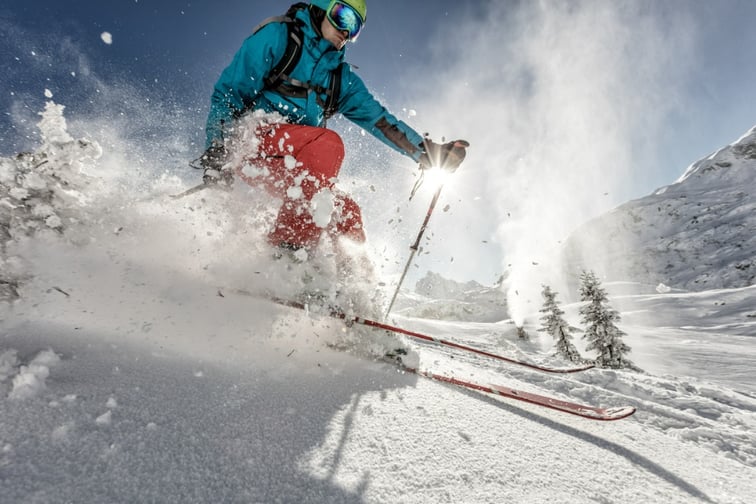

Downhill skiers account for 75% of Australians participating in snow and ice sports, according to data gathered by Sports Medicine Australia (SMA) – the country’s peak national umbrella body for sports medicine and sports science. The figure consists of skiers in varying age groups in skill levels.
Although taken from 2004 statistics – the last time the Exercise, Recreation, and Sports Survey (ERASS) was conducted for the sport – the percentage represents the popularity of downhill skiing among Australia’s snow sports-loving population.
During the period, injury rates for all types of skiing were estimated to be between 1.5 and 3.9 injuries per 1,000 visitor days. Also referred to as skier day, a visitor day indicates “one person purchasing a lift ticket for one day’s skiing or snowboarding,” according to the industry non-profit Australian Ski Areas Association (ASAA).
According to the survey, of all hospital admissions where the skiing type was recorded, 81% were downhill skiers. More than half, or 56%, of those injured were male, and over two-thirds (67%) were between the ages of 10 and 39.
“Evidence indicates that skiers with lower skill levels and less experience are more at risk of injury,” the SMA noted.
Falls were the top cause of injuries at 73%, with collisions with either an object or another person a distant second at 18%. Almost one-third (32%) of injuries were to the knee and lower leg, with fractures (61%), and sprains and dislocations (14%) forming the most common injury types.
“Downhill skiing is a physically demanding sport that requires strength, flexibility, endurance, fitness, good anticipation, and reflexes,” the association added. “The skier, their equipment, and the environment all play a role in both the occurrence and prevention of injury.”
And with ski resorts across the country and overseas expecting a surge of visitors with the lifting of quarantine restrictions, industry experts recommend that snow sports enthusiasts take out ski travel insurance as protection.
As the name suggests, ski travel insurance – also called ski insurance – is a type of policy designed for ski trips. Some insurers offer coverage under a snow travel or winter sports plan, which also covers other forms of outdoor winter activities, including snowboarding, luge, and snowmobiling. Ski or snow insurance is not typically included in a standard travel insurance policy but can be purchased as an add-on.
What a ski insurance plan covers differs between insurance providers, but ideally, skiers should look for a policy that offers coverage for:
Read more: Revealed – what the best travel insurance providers in Australia cover
Not everything that involves skiing, however, is covered under a ski insurance policy. Among the typical exclusions are:
Some ski travel insurance companies may also require claimants to obtain written confirmation from an appropriate authority confirming that a resort has been closed due to bad weather or an avalanche. Most travel insurers also do not provide coverage for extremely high-risk winter activities such as bobsleighing, snow rafting, parapenting, and ski acrobatics.
Most insurers only provide ski coverage for people under 65 because of the increased risk the sport poses to seniors, although some specialists may offer protection for senior-aged skiers.
But regardless of age, travellers must purchase a ski travel policy before their actual trip, which should begin and end in Australia.
Most insurers provide coverage for recreational skiing. Other forms of skiing, however, are rarely covered, which include the following:
The price of ski travel insurance premiums varies, depending on a range of factors, including:
The skier’s age: Typically, older skiers or those who have reached senior age, pay more for coverage because of the level of risk they are exposed to.
The ski destination: Some locations, including the US, have exorbitant medical costs, which drive up premiums.
The length of the trip: The longer the coverage is required, the higher the cost of insurance.
Level of cover: Premium prices are also higher for those who have taken additional coverage like those for high-value equipment and gear.
The excess: Choosing a higher excess typically reduces ski insurance costs, but policyholders are advised to keep the amount at a level that they can afford to pay.
Most travel insurance companies in the country offer coverage for ski holidays. Some specialise in providing protection for skiing and other snow activities. Here’s what some of the country’s top ski insurance providers in Australia offer in terms of coverage:
|
Insurer/Policy |
Key coverages |
|
1Cover Ski & Snowboarding Travel Insurance (Comprehensive) |
|
|
Budget Direct Ski Travel Insurance |
|
|
Columbus Direct Ski Travel Insurance |
|
|
Fastcover Snow Sports Plus |
|
|
InsureandGo Winter Sports Travel Insurance |
|
|
Medibank Ski & Snow Travel Insurance |
|
|
Ski-Insurance Ski Plus (International) |
|
|
Travel Insurance Direct Skiing and Snowboarding Insurance (The Works Plan) |
|
|
Virgin Money Snow Pack |
|
|
World Nomads Ski & Winter Sports Travel Insurance (Explorer Plan) |
|
